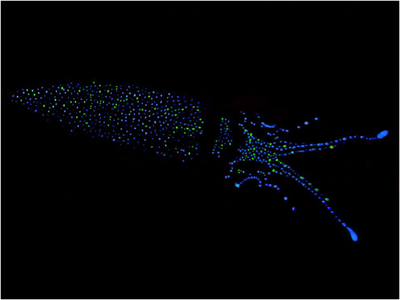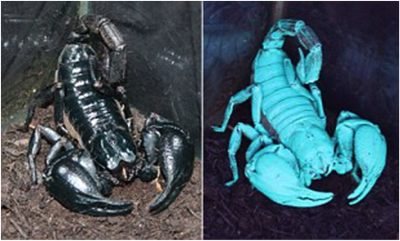Bioluminescence
Introduction
 Have you ever wondered what makes jellies, fish and algae “glow?” These animals and plants produce light through a process called bioluminescence (bio=life, luminescence=light). Bioluminescence, a chemical reaction, is the production and emission of light by a living organism.
Have you ever wondered what makes jellies, fish and algae “glow?” These animals and plants produce light through a process called bioluminescence (bio=life, luminescence=light). Bioluminescence, a chemical reaction, is the production and emission of light by a living organism.
In land (terrestrial) animals with bioluminescence such as fireflies and some beetles, green and yellow are the most common colors you’ll see, though red is sometimes seen. In marine animals, the colors are mostly blue-green to green, though red and yellow are seen also.
Bioluminescence has three main functions: finding or attracting prey, defense against predators and communication.
About 80 percent of all deep-sea creatures are bioluminescent. At 200 meters below the ocean’s surface, sunlight is scarce and very little plant life can survive. Sunlight does not penetrate the water below 1,000 meters (one meter is equal to about 3.28 feet, so 1,000 meters is about 3,280 feet or nearly ¾ of a mile). Most bioluminescent creatures live in the mesopelagic or twilight zone between 200- 1,000 meters.
 Terrestrial animals such as scorpions glow when a black light is passed over them. Corals seem to glow different colors when exposed to black light as well. But is this the same kind of glow as many deep sea creatures have? It’s not! Scorpions, corals and many other species reflect certain wavelengths of light, producing a glow that is called fluorescence (dictionary definition here). Fluorescence is the light given off by certain substances when it absorbs light or other electromagnetic radiation. Humans cannot see black light wavelengths. If you are wearing a white shirt and step into a room with black lights on, your shirt glows! This is fluorescence. When you step back to regular light, your shirt is normal white again. While many things fluoresce, it is not as amazing as bioluminescence!
Terrestrial animals such as scorpions glow when a black light is passed over them. Corals seem to glow different colors when exposed to black light as well. But is this the same kind of glow as many deep sea creatures have? It’s not! Scorpions, corals and many other species reflect certain wavelengths of light, producing a glow that is called fluorescence (dictionary definition here). Fluorescence is the light given off by certain substances when it absorbs light or other electromagnetic radiation. Humans cannot see black light wavelengths. If you are wearing a white shirt and step into a room with black lights on, your shirt glows! This is fluorescence. When you step back to regular light, your shirt is normal white again. While many things fluoresce, it is not as amazing as bioluminescence!
Conservation
We can help our local and global environment with these simple steps:
- Reuse items instead of throwing them away and recycle when you can.
- Reduce the amount of single-use plastic used in the home. Use a pitcher water filter and reusable water bottle instead of plastic bottles of water.
- Reduce water usage at home. For instance, turn the faucet off while you brush your teeth (helpful tips here).
- Ask your parents to shop for sustainable seafood (usually marked on the package). Learn about SeaFood Watch.
- Ask your parents to reduce or eliminate the use of commercial fertilizer around the yard – these chemicals runoff into the Rio Grande (eventually) causing harm to all the critters that live there (read more here).
Activity: Bioluminesce
Imagine you are in completely dark room. How do you navigate your surroundings? How do you find food? More importantly, how do you avoid predators? Bioluminescence is how! Short bursts of dazzling light may be used to scare a predator away or attract dinner. Since humans cannot bioluminesce, use a small flashlight to produce short bursts of light. Does that help you navigate the dark space? Do you think you would be able to find food? Are you able to detect a potential predator?
Write a few sentences that describe what it was like using a small flashlight as your only source of light in a dark room. Were you more sensitive to sounds? Were you more aware that you were exposed to (pretend) danger? Is it an advantage to be small or large?
Additional Resources for Teachers
NOAA’s Ocean Explorer lesson plans
Additional Resources for Students
Video of Monterey Bay Aquarium Jellies
